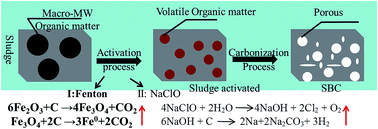Typical MSW odor abatement using sludge derived carbon prepared by activation with Fenton’s reagent and NaClO
Abstract
Sludge derived carbon (SBC) is a potential resource from sewage sludge disposal, and chemical pre-treatment is a necessary activation method for the improvement of the SBC quality. Two novel activators, i.e. Fenton and NaClO, were introduced to produce SBC precursors through the destruction of cell wall barriers and heterogeneous structures in sludge. High quality SBC-Fenton and SBC-NaClO were produced, with the BET having increased from 38 m2 g−1 in the control group to 253 m2 g−1 and 423 m2 g−1, respectively. The micro-porosity volume increased from 6% to 42% and 46% in the SBC-Fenton and SBC-NaClO, respectively, with the corresponding saturation adsorption capacity increasing from 33.1 mg g−1 to 71.5 mg g−1 and 67.8 mg g−1 based on Langmuir isotherms using methylene blue. The adsorption processes of the typical odorants H2S and NH3 were also tested using the SBC-Fenton and SBC-NaClO, which could reduce the landfill volume and odor emissions simultaneously, and around 2.1 mg g−1 and 0.68–2.24 mg g−1 of NH3 and H2S were adsorbed under different dosages. SBC could be a promising adsorption carrier and supporting substance for soil cover in landfills.


 Please wait while we load your content...
Please wait while we load your content...